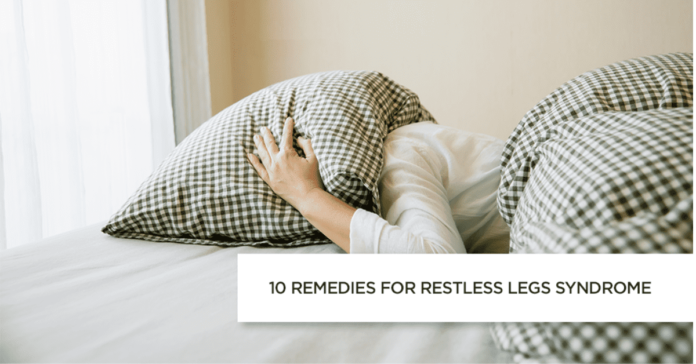Restless Legs Syndrome (RLS), also known as Willis-Ekbom disease, is a nervous disorder which leads to an strong urge to move your legs. Doctors consider this disease a sleep disorder as it usually happens or gets worse while you are at rest.
The symptoms of RLS primarily occur when you are sitting, resting, or sleeping. You are likely to witness them at night. Restless leg syndrome can cause serious sleep problems. A treatment plan is highly useful to relieve your RLS symptoms. Your doctor may discuss this with you based on the severity of the symptoms.
The following are the top 10 remedies for restless legs syndrome :
- Healthy Habits
You should avoid alcohol, caffeine, and nicotine consumption several hours before bedtime.
- Reviewing Medications
Certain medications like antihistamines, anti-nausea drugs, antipsychotic drugs, usage of lithium, or tricyclic antidepressants can aggravate RLS symptoms. Your doctor should be aware of the medicines you are using. Consult your doctor immediately if you witness the worsening of RLS symptoms.
- Treatment of Underlying Cause
Health conditions like end-stage renal disease, nerve damage due to diabetes, and iron deficiency anaemia can cause restless legs syndrome. Treating these conditions may help in treating RLS too. Your doctor will discuss your health condition and advise you on the most suitable treatment plan. They will ask you to get your blood tested for iron levels and kidney function. Vitamin D deficiency is also linked to RLS. Your doctor will prescribe you some vitamin D supplements that could reduce RLS symptoms. For those people on hemodialysis, vitamin C and vitamin E supplements relieve the symptoms.
- Healthy Sleep Habits
You should maintain a regular sleep schedule and avoid daytime naps. Try keeping your sleeping area dark and quiet in order to calm your body. Distractions like TV and phone should be minimized in the bedroom. These lifestyle changes will help you offset some of the effects of restless legs syndrome.
- Exercise and Yoga
Make sure you exercise every day. Stretching and massaging your legs at the starting and end of the day can be beneficial in this syndrome. Aerobic exercises and lower body resistance training like squats, lunges, etc…helps lessening the symptoms of RLS.
Yoga alleviates depression and mood swings along with the RLS symptoms. It assists in reducing stress levels, which benefits the sleep cycle. Massage improves circulation and increases the release of dopamine. This has shown improvements in patients with restless legs syndrome.
- Medications
Your doctor will prescribe the most suitable medication for you after your diagnosis. Most commonly prescribed medications are as follows –
● Dopamine agonists – Drugs like pramipexole, rotigotine, and ropinirole enhances the neurotransmitter dopamine for the brain. Their side-effects are daytime sleepiness, nausea, and lightheadedness.
● Dopaminergic agents – Drugs like these also increase the level of dopamine in the brain. This helps in improving the uncomfortable leg sensations. Medicine overdose can result in the worsening of symptoms. Nausea, vomiting, and hallucinations can occur as side-effects.
● Benzodiazepines – drugs like these are sedatives. They assist in the sleep cycle.
● Opiates – these drugs are pain relievers. Your doctor will prescribe opiates only when other drugs don’t work.
● Anticonvulsants – These drugs help relieve RLS symptoms and chronic pain due to nerve damage.
- Foot Wrap
This process is known as Restiffic. The foot wrap exerts pressure on specific points at the sole of your foot. These sensations send a message to the brain to relax the affected muscles. This process resolves the RLS symptoms. Your doctor will prescribe you the Restiffic foot wrap if you desire.
- Pneumatic Compression
This is an in-hospital treatment. The process involves the usage of a sleeve. It goes over the affected limb. It first inflates and then deflates, gently squeezing your legs. The pneumatic compression device is widely used to enhance circulation. It also prevents the formation of any clots. Pneumatic compression can assist in reducing RLS symptoms.
- Electrical stimulation
A vibrating pad is used to stimulate your feet and toes with vibrations. Sometimes electric impulses are also used to get relief from RLS symptoms. You can use this pad while resting or sleeping. These vibrations provide counter stimulation. They work by overpowering the symptom’s sensation by their vibrating intensity. Thus, you will feel the vibration instead of your painful symptoms. It has shown successful results in improving the sleep cycle.
- NIRS – Near-Infrared Spectroscopy
It is a non-invasive treatment but not widely performed. This is a painless procedure in which light beams are used. They penetrate your skin and cause your blood vessels to undergo dilation. This leads to increased circulation. Doctors believe that RLS may be due to the low oxygen level in the affected limb. Increased circulation with Near-Infrared Spectroscopy can relieve the symptoms of restless legs syndrome.
Also Read About: Normal Oxygen Level in Human Body
Restless legs syndrome can be a lifelong condition. Some coping and supporting strategies can ease the process of living with it. Try not to suppress your movements forcibly . This can result in the worsening of symptoms.
Your doctor will advise you on the right treatment plan for you . You might have to try several drugs to land on the perfect treatment. Restless legs syndrome can cause immense discomfort and sleep issues, so treatment should not be ignored.


















